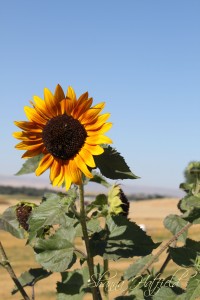I don’t know what it is, but there is something about sunflowers, particularly against the backdrop of wheat fields and blue sky that just screams summer to me.
It probably harkens back to the days of my childhood when wheat harvest was an important part of the summer activities I tried to avoid. The edges of the fields often had volunteer sunflowers waving their bright little heads in the breeze. I always thought they were cheery and fun. My dad thought they were just one step above noxious weeds.
To me, sunflowers are nostalgic and old-fashioned, bringing to mind simpler times.
Sunflowers have been around for centuries. In fact, they started in North America but commercialization of the plant took place in Russia.
Evidence suggests that sunflowers were cultivated by Native Americans in present-day Arizona and New Mexico around 3000 BC. A few archaeologists even suggest sunflowers may have been domesticated before
corn.
Sunflowers were used in many ways throughout various tribes. Seed was ground into flour for cakes, mush or bread. Sometimes it the meal was mixed with vegetables such as beans and squash. Seeds were also cracked open and eaten for snacks. Sunflowers were also used for dye, and medicinal treatments. The oil of the seed could be used on skin and hair. Dried stalks were sometimes used in building material.
Sunflowers were used in many ways throughout various tribes. Seed was ground into flour for cakes, mush or bread. Sometimes it the meal was mixed with vegetables such as beans and squash. Seeds were also cracked open and eaten for snacks. Sunflowers were also used for dye, and medicinal treatments. The oil of the seed could be used on skin and hair. Dried stalks were sometimes used in building material.
Spanish
explorers carried the plant to Europe around 1500. Sunflowers were used throughout present-day Western Europe mainly in an ornamental capacity, although there were also some medicinal uses.
In the early 1700s, an English patent was granted for squeezing oil from sunflower seeds.
By 1830, the manufacture of sunflower oil was a commercial enterprise. The Russian Orthodox Church increased the popularity of sunflowers by forbidding most oil foods from being consumed during Lent. However, sunflowers weren't on the list of prohibited items and soared in popularity.
By 1830, the manufacture of sunflower oil was a commercial enterprise. The Russian Orthodox Church increased the popularity of sunflowers by forbidding most oil foods from being consumed during Lent. However, sunflowers weren't on the list of prohibited items and soared in popularity.
Russian farmers were reportedly growing more than two million acres of sunflower in the early years of the 19th century. During that time, two specific types emerged — one based for oil production and another variety for direct consumption.
The late 1800s saw a return of sunflowers to the United States. Seed companies advertised the 'Mammoth Russian'
sunflower seed in catalogues. This particular seed name was still being
offered nearly 100 years later.
The next time stop to admire a cheerful sunflower blossom, think about the circuitous route it took to get there.
~*~
When this hopeless romantic isn’t
writing or indulging in rich, decadent chocolate, Shanna hangs out with her
husband, lovingly known as Captain Cavedweller.
Contact the Author:
Find Shanna’s books at:
Amazon
| Amazon
UK | Barnes &
Noble | Smashwords
| Apple
Shanna loves to hear from readers. Follow her online at:
ShannaHatfield | Facebook | Newsletter | Pinterest | Goodreads
| You Tube
| Twitter









Interesting post, Shanna! I enjoyed learning about sunflowers. Now I'll forever associate them with your sunny disposition. =)
ReplyDeleteAw, you are so sweet, Kristin! Thank you! :)
ReplyDeleteI've always loved sunflowers also, and eat seeds continually. I wasn't aware of the history and for that I thank you. I always love these peices of the past. Angela/Doris
ReplyDeleteI learn so many great bits of historical info from the SAS authors. Thank you, Doris! :)
DeleteEnjoy those sunflower seeds!